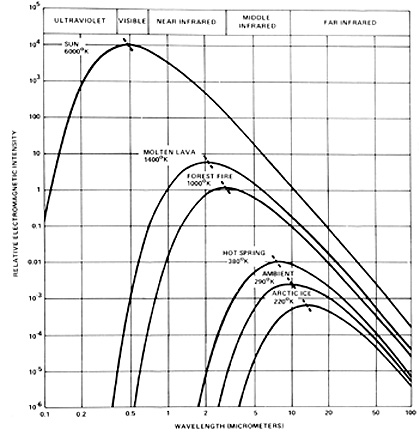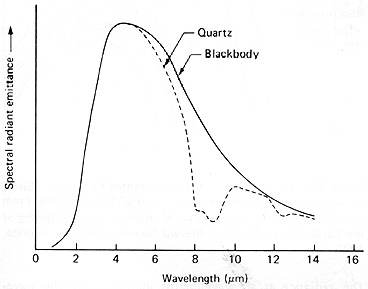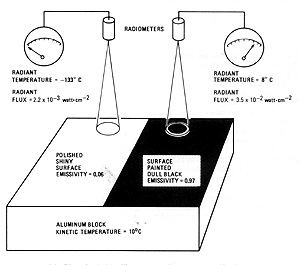

The Wien Displacement Law and Emissivity Effects

The above figure (also shown on page 8-8) plots spectral wavelength versus emitted radiance (as intensity) from thermal radiators at various peak radiant temperatures ranging from that of the Sun to the Earth's surface (average ambient temperature and sea ice). The hotter the radiating body, the greater is its radiance (intensity on the ordinate) over its range of wavelengths, and the shorter is its peak emission wavelength. The relation between peak wavelength and radiant body temperature is the Wien Displacement Law:
l m T = 2898
where l m is the wavelength at maximum radiant emittance and T is the absolute temperature in degrees Kelvin ( °C + 273). The constant, 2898, is in units of µm °K. It is also given as (rounded off) 0.29 cm °K. For the Sun, with a photospheric radiant temperature of about 6000 °K, this peak is in the visible (centered on 0.58 µm). A forest fire peaks around 5.0 µm. The Earth, as observed from space, peaks within the 8-14 µm interval.
9-1: What is the peak wavelength for a lamp that glows at 1800° C? ANSWER
A body's temperature can represent one thermal state but be expressed by two temperatures: the first is its internal temperature (from the kinetic motion of its atoms) as measured by an inserted thermometer whereas the second is the external temperature measured by its emitted radiation. The radiant flux FB emanating from a body is related its internal (kinetic) temperature Tk by the Stefan-Boltzmann Law, which in simplified form is given as FB = sTk4, where s (often given by the Greek letter, small sigma) is a constant given as 5.67 x 10-12 W(atts) × cm-2 × ¡K-4. Strictly, this equation holds only for perfect blackbodies.
9-2: Calculate the value of Fr for a blackbody having a temperature of 17° C. ANSWER
The quantity of radiant emission, and thus the effective temperature that is measured externally as radiation, also depends on the emissivity e of the object in the spectral region of interest. Emissivity is a dimensionless number that expresses the ratio of the radiant flux of a real material FR to the radiant flux of a perfect blackbody FB (one that completely absorbs incoming radiant energy, with none being partitioned into transmitted or reflected components), or FR/FB = e .It is a measure of the efficiency of emitted radiance of any real body to that of a perfect radiator (for which e = 1.0). Values of e vary from 0 to 1 and are spectrally dependent, i.e., can change with ![]() . Here is an example comparing the spectral radiant emittance of the common mineral quartz to a perfect blackbody when they are at thermal equilibrium at a given temperature (here, at 600 °K).
. Here is an example comparing the spectral radiant emittance of the common mineral quartz to a perfect blackbody when they are at thermal equilibrium at a given temperature (here, at 600 °K).

From T.M. Lillesand and R.W. Kieffer, Remote Sensing and Image Interpretation, 2nd Ed., © 1987. Reproduced by permission of J. Wiley & Sons, New York.
9-3: What is the radiant flux FR for a real body having the same kinetic temperature as in question 9-2, and also having an emissivity of 0.9. ANSWER
The sharp decrease in ![]() in the 8-10 µm region, noted for quartz and other silicates, is a "reststrahlen" effect (decreased emission) related to thermally induced stretching vibrations within silicon-oxygen bonds. In general, for opaque materials, e l = 1 - r l , where rho is the materials optical reflectance. Thus, as
in the 8-10 µm region, noted for quartz and other silicates, is a "reststrahlen" effect (decreased emission) related to thermally induced stretching vibrations within silicon-oxygen bonds. In general, for opaque materials, e l = 1 - r l , where rho is the materials optical reflectance. Thus, as ![]() , with high reflectance of radiation (poor absorptance), the emittance will be low (thus, thermal radiation decreases). Water, which has a high emissivity in the thermal infrared in the 8-10 µm interval, is a poor reflector over that range; quartz (and many silicate rocks) is a good emitter at lower thermal wavelengths but poor in this interval. From this, one might predict that rock surfaces would appear darker than water in the 8 -10 µm interval but this holds only for certain conditions, as we will shortly see.
, with high reflectance of radiation (poor absorptance), the emittance will be low (thus, thermal radiation decreases). Water, which has a high emissivity in the thermal infrared in the 8-10 µm interval, is a poor reflector over that range; quartz (and many silicate rocks) is a good emitter at lower thermal wavelengths but poor in this interval. From this, one might predict that rock surfaces would appear darker than water in the 8 -10 µm interval but this holds only for certain conditions, as we will shortly see.
The radiant (sensed) temperature differs from a body's kinetic (internal) temperature according to the relation T = e 1/4 TK ; for real bodies (known as gray bodies) radiant temperatures are always less than kinetic temperatures. Thus, checking the figure below, the radiant temperature is significantly higher for a blackened surface (high e ) than for a shiny surface (lower e ), even if the two materials are at the same kinetic temperature.

From F.F. Sabins, Jr., Remote Sensing: Principles and Interpretation. 2nd Ed., © 1987. Reproduced by permission of W.H. Freeman & Co., New York City.
9-4: For the real body we considered in question 9-3, what is its radiant temperature? ANSWER

Collaborators: Code 935 NASA GSFC, GST, USAF Academy
Contributor Information
Last Updated: September '99
Webmaster: Bill Dickinson Jr.
Site Curator: Nannette Fekete
Please direct any comments to rstweb@gst.com.